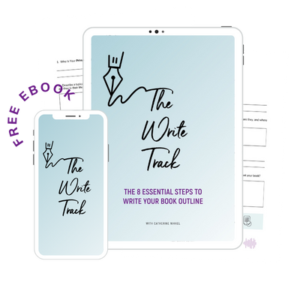Memoir writing is an art that involves compellingly sharing personal, life-changing experiences. It’s a process that requires an ability to dive into one’s own life story, to struggle to make sense of past events, and to present them in a manner that not only holds the reader’s interest but also resonates on an emotional level.
Suppose you’ve ever thought about writing your own memoir. In that case, it’s important to understand the whole writing process and what it entails. In this post, we will provide insights into how to write a memoir outline, an essential step in the memoir writing process. The outline provides a roadmap you can follow as you start writing, allowing you to focus on your narrative while keeping track of your story’s structure.
→ Download my book and memoir outline here to help you stay on the ‘write track’
The Importance of a Memoir Outline
Before you start writing your memoir, creating an outline is crucial. A memoir outline is the foundation of your personal story. It provides structure and direction, ensuring you stay on course as you delve into your memories. It can be as detailed or as high level as you want. Still, two key elements should always be clear: the story arc (or narrative arc) and the significant events (or turning points) of your life.
The story arc is your memoir’s structure, typically a chronological order of events that forms a cohesive narrative. On the other hand, the turning points are the significant events or life experiences that significantly impacted your life and led to personal growth or change.
How to Start Your Memoir Outline
Begin writing your memoir outline by identifying these two key elements. Start with the turning points in your life. These are moments that have significantly shaped who you are today. They could be anything from moving to a new city, a childhood experience, your first job, the loss of a loved one, or any other experience that profoundly impacted your life.
Once you have a list of these turning points, you can start forming your story arc. This will involve placing your turning points chronologically and building a narrative around them. Remember, a remarkable memoir doesn’t just recount events—it explores the emotions, motivations, and lessons learned from these experiences.
Think about the overall journey of your life and how these turning points have shaped your path. Consider the themes that emerge from your experiences. Themes could be resilience in the face of adversity, the quest for identity, the power of love, or the impact of societal norms on personal growth, among others.
You don’t have to write a memoir of the entire life story at this stage. The idea is to get a sense of the whole book’s structure and the key elements that will drive your memoir forward. As you write your memoir outline, be prepared to dig deep into your memories and bring your personal story to life.
Structuring Your Memoir Outline
The structure of your memoir outlines also plays a crucial role in how effectively your story is conveyed to your readers. One method is to structure your memoir outline chronologically, but remember that your life isn’t a list of events. It’s a complex weave of experiences, lessons, emotions, and growth. Thus, while your memoirs might follow a chronological structure, the emphasis should be on the thematic elements and the emotional journey.
Consider using a narrative arc in your memoir outline. The narrative arc, also known as the story arc, is your story’s path. It involves a beginning (the setup), a middle (the confrontation), and an end (the resolution).
Beginning
The beginning is where you introduce the reader to yourself, setting the stage for the experiences and stories that you will share. This is where you draw your readers in, giving them a reason to invest in your personal journey. Share glimpses of your life that hint at the experiences to come.
Middle
The middle is the heart of your true story here, where you explore your life’s main events, experiences, and turning points. This is the most substantial part of your memoir. The intensity should rise as you move through the turning points, drawing your reader deeper into your real life and story.
End
In the end, you bring your story to a close, reflecting on the journey and lessons learned. This is your chance to leave your readers with something to ponder, a lesson learned, a takeaway that transcends the pages of your memoir.
Weaving in Your Life Experiences
With the narrative arc as your framework, begin weaving in your real life and experiences. Consider your turning points as milestones within this framework. These pivotal moments are like signposts that guide your story forward. They serve as the pillars of your memoir outline.
As you structure and write your memoir outline, keep your readers in mind. A good memoir is not a diary. It is a narrative that takes readers on a journey. Your life experiences are the vehicle for this journey. Still, how you write about these experiences, the insight you provide, and the emotional truth you convey about particular experiences will truly engage your readers.
Making Your Memoir Compelling
A compelling memoir is not just about writing a compelling story; it’s about creating an experience. As a memoir writer, you’re taking your readers on a journey through your life. Here are some elements to focus on to make your memoir compelling.
Authenticity
The power of memoirs lies in their authenticity. Be honest and open about your experiences and feelings. Authenticity resonates with readers, makes your memoir relatable, and imbues your narrative with a unique voice.
Detail and Description
Details bring your memoir to life. Use descriptive language to vividly describe your experiences, settings, and characters. This helps immerse readers in your story and make them feel like they are experiencing the events alongside you.
Show, Don’t Tell
Rather than just narrating the events, show them through actions, thoughts, dialogues, and emotions. This allows writers and readers to interpret the events from their own experience and form a connection with your narrative.
The Importance of Theme in Your Memoir
While your personal memoir is based on your personal experiences, it should revolve around a central theme. This theme is the thread that ties your life experiences together, giving your personal memoir a sense of coherence and purpose.
Identifying the theme of your memoir can take some introspection. Think about the recurring patterns, the life lessons, the turning points in your childhood home and life, and how they have shaped you.
For example, if you’ve moved around a lot in your life, your theme post could be about finding a home within yourself. If you’ve faced adversity, your theme could be resilience and personal growth.
Memoir Vs. Autobiography: Understanding the Difference
While memoirs and autobiographies recount stories from the author’s life, they differ in scope and purpose. An autobiography typically covers the author’s life, often written chronologically. Conversely, a memoir focuses on specific aspects or periods of the author’s life. It’s more about the lessons learned and the insights gained rather than a comprehensive life history.
A good memoir doesn’t necessarily cover your whole life; it delves deep into your unique experiences, emotions, and perspective. It’s more about depth than breadth. For example, Roxane Gay’s ‘Hunger’ is a memoir focusing on her experiences with body image and weight, not a chronology of her entire life.
Maintaining Focus in Your Memoir Writing
Writing a memoir can feel overwhelming, especially when trying to make sense of your life’s worth of experiences. That’s why maintaining focus is crucial. Here are a few tips to help you stay focused:
Stick to Your Outline
Your memoir outline is there for a reason. It helps you stay organized and focused. Refrain from veering off course. If new ideas or memories pop up, see if they align with your story arc and theme. If they do, you can weave them in; if they don’t, it might be best to leave them out.
Keep Your Theme in Mind
Your theme is the backbone of your best memoirs. Every scene you write, and every memory you share, should tie back to this theme. It might be a distraction if it doesn’t contribute to your overall theme or purpose.
Break It Down
Don’t try to write your memoir all at once. Break it down into manageable sections or chapters. Focus on one story or period at a time.
Writing a memoir is a journey, one that takes courage and patience. Keep writing, stay true to your voice, and remember – you have a compelling story to tell that deserves to be shared. Let’s keep going!
Once you’ve identified your theme, use it as a guide as you outline and write your memoir. It should echo through your experiences, providing depth and insight into your personal story.
Writing the First Draft: Letting Your Story Flow
When you begin writing the first draft of your memoir, let go of perfection. This stage of starting writing is not about creating a polished piece of literature; it’s about getting your life story out of your head and onto the page. Think of it as laying the foundation of your memoir, which you’ll refine and build upon in the revision stages.
To keep the ball rolling:
- Allow yourself to write freely.
- Don’t worry about spelling, grammar, or finding the perfect words.
- Focus on your memories, feelings, and experiences.
- Remember, you’re the only one who will see this draft, so be candid.
Using Bullet Points
Consider using bullet points if you find it hard to write in paragraphs. Bullet points can help you jot down key events, moments, and memories without worrying about sentence structure or flow. You can continually expand on these points later.
Write About Your Turning Points
Turning points are crucial moments in your life that spark change or growth. These moments shaped you and your worldview, so they’re essential to your memoir. Reflect on each moment of your turning points and describe them in detail, focusing on your feelings and reactions.
The Revision Process: Shaping Your Story
After you’ve written your first draft, it’s time to shape your story. In this stage, you’ll work on your narrative arc, develop your characters (including yourself), and refine your voice.
Story Structure and Narrative Arc
Look at your story as a whole. Does it have a clear beginning, middle, and end? Does it follow a compelling narrative arc with rising action, a climax, and a resolution? If not, you may need to rework your outline or move some pieces around.
Showing vs. Telling
One key element of good memoir writing is the ability to show rather than tell. Instead of simply telling your readers what happened, show them by using sensory details, emotions, and dialogue.
Seeking Feedback
Once you’ve written or revised your memoir to the best of your ability, consider seeking feedback from others. This can be a writing group, a trusted friend, or a professional editor. They can provide valuable insights and point out any areas of confusion or weakness.
Writing a memoir is a deeply personal and rewarding process. Remember, this is your story, told in your voice. Be authentic, be patient with yourself, and most importantly, enjoy the journey!
Overcoming Writer’s Block: Keeping the Momentum
Writing a memoir is a monumental task, and it’s not uncommon to encounter writer’s block. It can manifest as a lack of ideas, a fear of the blank page, or feeling stuck in a particular section. Here are some tips to keep you moving forward.
Engaging in Other Creative Activities
Creativity breeds creativity. If you’re feeling stuck, engaging in other creative activities can help. This can be anything from painting to cooking to gardening. These activities can help your mind relax and spark new ideas for your next travel memoirs.
Revisiting Your Memoir Outline
If you’re stuck on a particular part of your memoir, revisit your outline. It’s possible that a part of your memoir isn’t working because it doesn’t fit into the overall narrative arc of your story. Consider whether each section of your memoir moves your story forward and aligns with your theme.
Allowing Time for Reflection
Memoir writing is deeply personal and can bring up a lot of emotions. If you’re feeling overwhelmed, taking a break and allowing yourself time to process your thoughts and feelings is okay.
Staying Motivated: Enjoying the Journey
Writing a memoir is a marathon, not a sprint. Here are some ways to keep your motivation high:
Celebrate Small Wins
Remember to celebrate your progress, no matter how small. Complete a difficult chapter? Wrote your first 1000 words? Celebrate these wins. They’re signs of your progress and commitment to telling your story.
Connect with Other Memoir Writers
Joining a community of aspiring memoirists and writers can provide a sense of camaraderie and valuable feedback and encouragement. Hearing about other people’s experiences can also provide inspiration and new perspectives for your memoir.
Remind Yourself of Your Why
Remind yourself why you wanted to write a memoir in the first place. Whether to share your story, leave a legacy, or challenge yourself, keep this reason at the forefront of your mind to fuel your motivation.
Writing a memoir is a journey of self-exploration and creativity. It takes time, patience, and resilience. Still, the end product – a book that encapsulates your life experiences – is an accomplishment to be proud of. In the next section, we’ll answer frequently asked questions about memoir writing.
Frequently Asked Questions About Writing a Memoir
What are the 5 parts of a memoir?
The five critical parts of a memoir include:
- Orientation: This part sets the stage for your memoir. It might provide background information about you, your family, the time period, or the location where your story took place.
- Rising Action: This section involves building your story. Here, you recount the events that led to your memoir’s central conflict or turning point.
- Climax: This is the turning point of your memoir, the moment of highest emotional intensity. This part usually involves a significant life event that shaped who you are today.
- Falling Action: This section is about the aftermath of the climax and the events that followed it.
- Resolution: This part concludes your memoir, tying together the narrative and showing how the events of your story have shaped you as a person.
What 3 things should be in a memoir?
A memoir should include the following:
- Personal Reflection: A memoir is more than recounting events; it’s about reflection and lessons learned.
- A Strong Narrative Arc: Like any good story, a memoir needs a solid narrative arc with rising action, a climax, and a resolution.
- Authenticity: A memoir should be honest and authentic. It should express your true feelings and experiences.
What is memoir format?
A memoir format follows a narrative structure similar to a novel. It typically includes setting, character development, conflict, climax, and resolution. However, unlike a novel, the events and characters in a memoir are actual and have significantly influenced the author’s life.
Use your Voice, Make an Impact.
Catherine x

Email: catherine@catherinenikkel.com
Resources
What type of Content Creator are you? Take the Quiz! – 4 different types of creators, which one are you?
Need help telling your story in your own voice? Let’s make it happen. Schedule a consultation with me here






